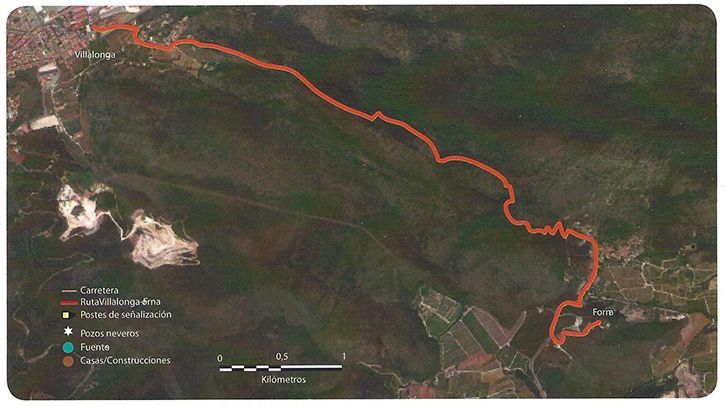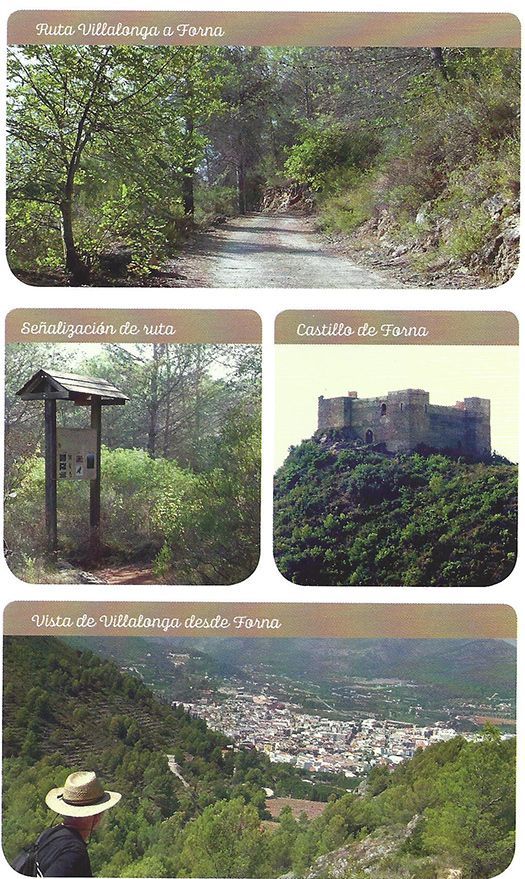La pequeña población de Forna se sitúa al Este de Villalonga, separada por barreras montañosas, como la Costera Alta, un camino que va por encima de la sierra une ambos pueblos.
La senda que une Villalonga con Fama, era la antigua vía de comunicación de estas dos poblaciones, antiguamente tan unidas, de hecho Forna pertenecía a la parroquia de Villalonga y los lazos de unión entre las dos poblaciones han sido siempre muy fuertes.
Es una ruta sencilla, pintoresca y atractiva, suave y solitaria. El paisaje no está transformado por urbanizaciones, cosa que revaloriza el paraje. La podemos hacer con un mínimo esfuerzo en apenas hora y media el trayecto de ida, ya que la ruta es lineal, por lo tanto tendremos que regresar por el mismo camino.


Comenzaremos nuestro trayecto desde la fuente del Paseo de la población, donde se recomienda llenar la cantimplora, e iremos a buscar la calle de Sant Llorenç al final de la cual empieza el «Camí de Forna». El primer tramo es de asfalto y con una fuerte pendiente que acaba cuando llegamos al último chalet, ahí comienza la senda de tierra, que se adentra por un bosque de pinos, después vamos hacia la izquierda, en donde hallamos un cruce que baja al «Barranc del Castell», el cual se queda al fondo, desde aquí se disfruta de unas magníficas vistas del Castell de Villalonga y de buena parte de la Comarca de la Safor.
La senda va subiendo suavemente entre pinos, romeros y «cepells» por la sombra de la «Font del Grill». En el punto más alto de la ruta (350 m.s.n.m.) llegamos a otro cruce a la izquierda que en unos 15 minutos nos llevaría a la «Fonteta del Grill» , hay que tener en cuenta que esta fuente, en años de lluvia tiene un agua fresca y muy buena, pero en años de sequía podríamos echarla de menos, por lo que se recomienda llevar agua para la ruta. Nosotros continuamos hacia Forna y pronto divisamos la caseta y el secano de “Baejero”, en donde se mezclan los pinos, palmitos y algarrobos. Cerca de allí se ha colocado un panel informativo de la ruta, justo en el límite del término de Villalonga, ya que a partir de ese punto entramos en el término de Forna. Pocos metros después encontramos un tercer cruce que nos llevaría a les «Fontanelles», desde aquí ya se ven las montañas de la Marina y si hacemos una breve parada para descansar a la sombra de los pinos, reconoceremos algunos de los parajes que nos rodean como «les revoltes d’Orba» y los chalets más altos de la Llacuna o enfrente la montaña del Xelibre, pero nuestro destino está más adelante, cuando la senda baja, primero suavemente y después con un fuerte descenso entre una pinada que nos deja de nuevo en el asfalto de los primeros chalets de Forna, desde ahí ya se ve sobre un cerro el majestuoso castillo, cruzando la urbanización bajamos hasta la plaza del pueblo, justo ante la iglesia. Podemos alargar la ruta unos 10 minutos más, vale la pena acercarse al Castillo de Forna que perteneció al caudillo árabe Al-Azraq. A los pies del castillo hay un área recreativa donde podemos recuperar fuerzas antes de retomar el camino de vuelta.

Más información en la página web del Ayuntamiento de Villalonga: www.villalonga.es.


@2024 – Aviso Legal. El uso de este sitio web constituye la aceptación de la Política de Privacidad. Diseñado por Wellaggio Agencia Web.
Casa Babel
We firmly believe that the internet should be available and accessible to anyone, and are committed to providing a website that is accessible to the widest possible audience, regardless of circumstance and ability.
To fulfill this, we aim to adhere as strictly as possible to the World Wide Web Consortium’s (W3C) Web Content Accessibility Guidelines 2.1 (WCAG 2.1) at the AA level. These guidelines explain how to make web content accessible to people with a wide array of disabilities. Complying with those guidelines helps us ensure that the website is accessible to all people: blind people, people with motor impairments, visual impairment, cognitive disabilities, and more.
This website utilizes various technologies that are meant to make it as accessible as possible at all times. We utilize an accessibility interface that allows persons with specific disabilities to adjust the website’s UI (user interface) and design it to their personal needs.
Additionally, the website utilizes an AI-based application that runs in the background and optimizes its accessibility level constantly. This application remediates the website’s HTML, adapts Its functionality and behavior for screen-readers used by the blind users, and for keyboard functions used by individuals with motor impairments.
If you’ve found a malfunction or have ideas for improvement, we’ll be happy to hear from you. You can reach out to the website’s operators by using the following email
Our website implements the ARIA attributes (Accessible Rich Internet Applications) technique, alongside various different behavioral changes, to ensure blind users visiting with screen-readers are able to read, comprehend, and enjoy the website’s functions. As soon as a user with a screen-reader enters your site, they immediately receive a prompt to enter the Screen-Reader Profile so they can browse and operate your site effectively. Here’s how our website covers some of the most important screen-reader requirements, alongside console screenshots of code examples:
Screen-reader optimization: we run a background process that learns the website’s components from top to bottom, to ensure ongoing compliance even when updating the website. In this process, we provide screen-readers with meaningful data using the ARIA set of attributes. For example, we provide accurate form labels; descriptions for actionable icons (social media icons, search icons, cart icons, etc.); validation guidance for form inputs; element roles such as buttons, menus, modal dialogues (popups), and others. Additionally, the background process scans all the website’s images and provides an accurate and meaningful image-object-recognition-based description as an ALT (alternate text) tag for images that are not described. It will also extract texts that are embedded within the image, using an OCR (optical character recognition) technology. To turn on screen-reader adjustments at any time, users need only to press the Alt+1 keyboard combination. Screen-reader users also get automatic announcements to turn the Screen-reader mode on as soon as they enter the website.
These adjustments are compatible with all popular screen readers, including JAWS and NVDA.
Keyboard navigation optimization: The background process also adjusts the website’s HTML, and adds various behaviors using JavaScript code to make the website operable by the keyboard. This includes the ability to navigate the website using the Tab and Shift+Tab keys, operate dropdowns with the arrow keys, close them with Esc, trigger buttons and links using the Enter key, navigate between radio and checkbox elements using the arrow keys, and fill them in with the Spacebar or Enter key.Additionally, keyboard users will find quick-navigation and content-skip menus, available at any time by clicking Alt+1, or as the first elements of the site while navigating with the keyboard. The background process also handles triggered popups by moving the keyboard focus towards them as soon as they appear, and not allow the focus drift outside it.
Users can also use shortcuts such as “M” (menus), “H” (headings), “F” (forms), “B” (buttons), and “G” (graphics) to jump to specific elements.
We aim to support the widest array of browsers and assistive technologies as possible, so our users can choose the best fitting tools for them, with as few limitations as possible. Therefore, we have worked very hard to be able to support all major systems that comprise over 95% of the user market share including Google Chrome, Mozilla Firefox, Apple Safari, Opera and Microsoft Edge, JAWS and NVDA (screen readers).
Despite our very best efforts to allow anybody to adjust the website to their needs. There may still be pages or sections that are not fully accessible, are in the process of becoming accessible, or are lacking an adequate technological solution to make them accessible. Still, we are continually improving our accessibility, adding, updating and improving its options and features, and developing and adopting new technologies. All this is meant to reach the optimal level of accessibility, following technological advancements. For any assistance, please reach out to